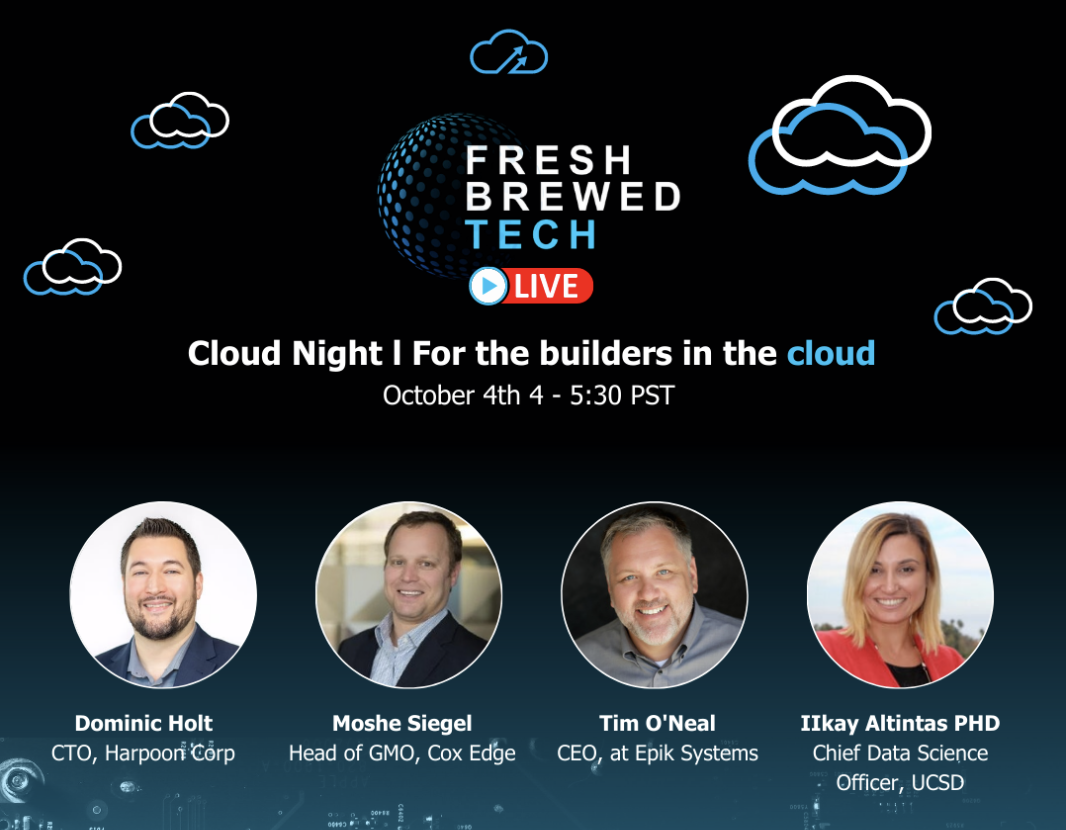Builders from various industries came together October 4th to discuss how Cloud is shaping industries and lives. The event, sponsored by Fresh Brewed Tech, Cox Edge and the Data Science Alliance allowed technology leaders to connect, share ideas and discuss how the Cloud is transforming our future.
Featuring key thought leaders — including Tim O’Neal, founder and CEO of EPIK Systems, a Dominic Holt, CTO for Harpoon, Ilkay Altintas, chief data science officer at UC San Diego & the SD Supercomputer Center, and Moshe Siegel, head of strategy, operations and finance at Cox Edge — segments focused on AI, Retail Tech, FinTech and No Low Code.
Here’s a glance at what was discussed during the segments:
On the Mainstage (Watch video from panel here)
Technology thought leaders O’Neal, Holt, Altintas and Siegel discussed various developments in edge computing and the Cloud during the mainstage segment.
Altintas told the audience that edge computing is a “mode of distributed computing” that can take many forms.
“This is programmable compared to traditional computing,” Altintas said. “We are seeing this type of distributed platform emerging in all kinds of areas, including in manufacturing, societal applications and scientific applications.”
In discussing use cases where edge computing played a key role, Siegel spoke about fast food giant Chick-fil-A, which re-engineered its ordering platform to process more users.
“It’s twice as fast by bringing the workload closer to the store,” Siegel said. “Edge is really about bringing the workload and service as close to the end user as possible. How can you reduce latency to increase that user experience?”
O’Neal also spoke about use cases in the agriculture industry where algorithms can be used to increase crop yield or reduce greenhouse gases.
“It’s reducing latency.” O’Neal said. “I want to get that latency down as much as possible. It’s about the reduction of latency.”
The reduction of latency ultimately means a reduction in delay for all users. Edge computing also applies to different domains. For example, Altintas spoke about the cases of wildfires where the edge can allow us to analyze data quickly.
“We can detect the smoke and determine what the effect of that smoke will be,” Altintas said. “It increases the confidence in the application and uses the data in the highest resolution possible.”
Although edge computing has its advantages, there are challenges in leveraging edge computing. O’Neal said leaders are required to take a “transformation step” while Siegel said “it’s a resource and design commitment.”
The Cloud in FinTech (Watch video of discussion here)
In the FinTech segment, Siegel of Cox Edge spoke about various changes in the financial industry thanks to the developments of technology. He said the two largest areas of growth have been electronic trading and payment.
“There are customers who are doing their real-time trading while leveraging the cloud for surveillance,” said Siegel, who noted its reducing significant amounts of work. “A number of these exchanges have pushed to move the market data, which have just as much value to the broader market community.”
For payments, Siegel used an example of an app where users can share payments such as a table of 10 friends at a restaurant trying to split a bill. The cloud allows people to use a payment app where it’s distributed as quickly as possible. The same can be applied to business-to-consumer payments, he said.
Cox Edge has played a vital role in helping the financial industry shape its future. Cox has 23,000 miles of fiber in U.S. markets, sometimes being the only provider available. However, Siegel said, some businesses may benefit from a multi-cloud space.
“We’re big believers in the multi-cloud space,” Siegel said. “This is going to continue to grow.”
One guest of the FinTech segment commented on how the cloud has changed how we work. He recalled a time when he had a data center in San Diego and regulators required him to have a physical ID checkpoint rather than using a bio-metric scan.
Tech Shapes Up Retail Industry (watch video here)
Technology has vastly changed how the retail industry works. For starters, consumers are purchasing from online retailers more than ever, which has caused companies to look for security features.
O’Neal spoke about a national retail chain that turned to sales solutions to process notes and real-time AI.
“When you think of retail, it’s the whole end-to-end process,” O’Neal said. “There’s a number of different ways for leveraging the edge for security. More is changing on the backend and it’s interesting to see this trend developing.”
A guest of the segment spoke about his company, which offered a marketplace of cybersecurity consulting companies, a booming industry. While guests also spoke about the offerings of Cox Edge when it came to the retail space, other industries that have leveraged the edge include governments, manufacturing and utility companies.
Although there’s been an increase in interest in the cloud, experts expect hardware to remain competitive. More cloud solutions may also be available in the coming years.


